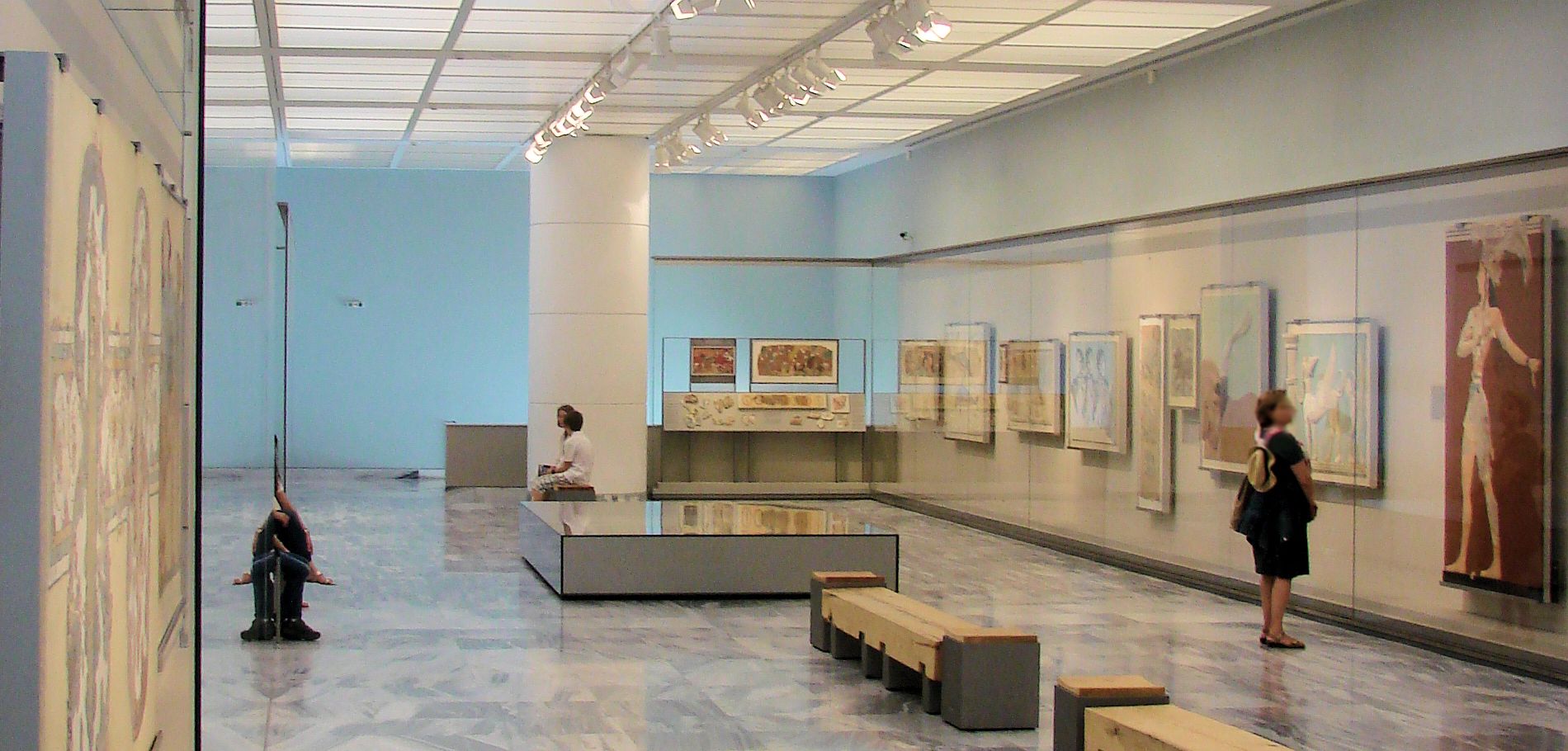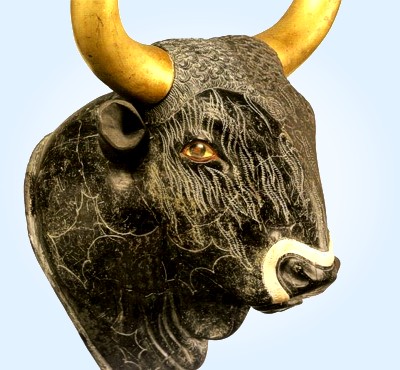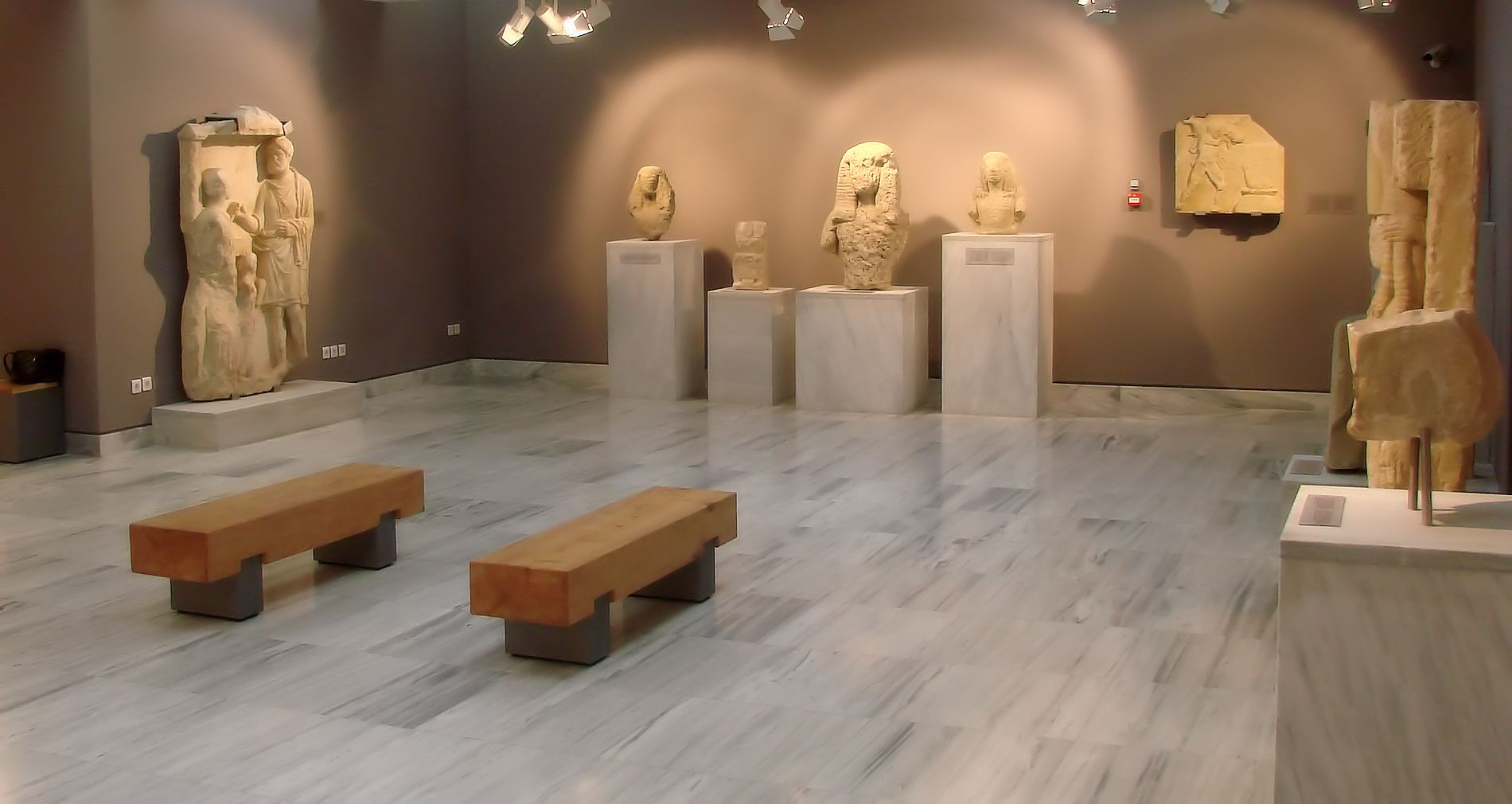|
Libation vase (rhyton) of serpentine, in the shape of a bull's head with inlays of shell, rock crystal and jasper in the muzzle and eyes. Little Palace, Knossos. New Palace period (1600 - 1500 BC)
Flask decorated with a large octopus and supplementary motifs: sea urchins, seaweed and rocks, an outstanding example of the mature marine style.
Palaikatsro (East Sitia), Late Neopalatial period.
Slender libation jug with spiky projections, decorated with painted papyrus flowers and nautilus.
From a grave at Katsambas (Iraklion), Final Palatial period.
Here the famous "Harvesters' Vase", a steatite oval rhyton decorated with a relief procession of men returning from their work in the fields.
From Agia Triada, Neopalatial period (1500 - 1450 BC).
The Minoans had evidently developed tools made of materials capable of cutting even the hardest stones.
Here a large lenticular sealstone, made of agate, depicting a goddess between griffins.
From Knossos, Final Ppalatial period (1450 - 1400 BC).
In the New Palace period bronze working was so flourishing that it became common for bronze to be used for works of miniature sculpture. The animal figures, usually smaller than the human ones, are of a great charm.
Here a bronze figurine of a seated wild goat, from Agia Triada, Neopalatial period (1600-1450 BC).
The art of the Minoan goldsmith reaches its zenith.
Here a gold pendant in the form of a lion.
From Agia Triada, Post Palatial period.
Silver pot (kylix) with gold plated handle and rim.
From a grave in Knossos area, Final Palatial period (1450 - 1350 BC).
A bronze sword with gold - sheathed hilt and gold - covered rivets, decorated with relief spirals.
From the cemetries of Knossos area, Final Palatial period (1450 - 1400 BC).
A gold votive double axe with incised decoration.
Arkalochori cave, Early Neopalatial period (1700 - 1600 BC).
Fresco painting was one of the most important forms of the Minoan art. Unfortunately the most surviving examples are fragmentary.
Here the "Blue Bird". A fresco with a blue bird sitting on a rock among plants and flowers, part of a larger composition..
From the "House of Frescoes" at Knossos, Neopalatial period (1550 - 1500 BC).

The most magnificent collection of Minoan art and culture in the world, unique in beauty and completeness is housed in the Museum of Herakleion; One of the largest, most important and most visited museums in Greece, and among the most important in Europe.
The museum's exhibition contains more than 15,000 artefacts, covering a period of 5,000 years, from neolithic era to Graeco Roman period.
The exhibits, collected from excavations carried out in all parts of Crete, come mainly from the prehistoric era (which takes its name from the legendary Cretan king, Minos) and form a valuable record of the artistic, social and economic life of the island during the ancient period.

They include examples of pottery in a variety of practical yet imaginative shapes ; stone carving of exceptional artistry ; seal engraving - one of the miniature arts at Minoan excelled; miniature sculpture of great sensitivity; gold work remarkable for the excellence of its technique and the variety of its subjects ; metalwork - household utensils, tools, weapons and sacred axes, carefully and ingeniously made ; and, finally, frescoes, which, with their harmoniously drawn figures and colorful compositions, give us an insight into a world characterized by tenderness, vitality, sensitivity and charm, a world which took a simple yet intense joy in life and nature.

Herakleion Archaeological Museum
The Herakleion Archaeological Museum is a Special Regional Service of the Hellenic Ministry of Culture - General Directorate of Antiquities. Its purpose is to acquire, protect, conserve, record, study, publish, display and promote Cretan artefacts from the Prehistoric to the Late Roman periods. It also organizes temporary exhibitions in Greece and abroad, collaborates with scientific and scholarly institutions, and houses a variety of cultural events.
Address
Xanthoudidou St. and Hatzidaki, 71202, Iraklion, Crete Greece (HELLAS)
Telephone: +30 2810 279086, +30 2810 279000
Fax: +30 2810 279071
Email: amh@culture.gr
Website: odysseus.culture.gr/h/1/ eh155.jsp?obj_id=3327
Tickets
From the 1st of November 2016 until the 31st of March: 5€
From the 1st of April 2016 until the 31st of October:
Full: €12, Reduced: €6
Special ticket package (Heraklion Archaeological Museum and Knossos): Full: €16, Reduced: €8
The special ticket package is valid for 3 days.
Information on admission fees, holidays, special days etc
In and around Show All Tourism facilities Regional interest Towns & Villages Sightseeing Beaches
|
|